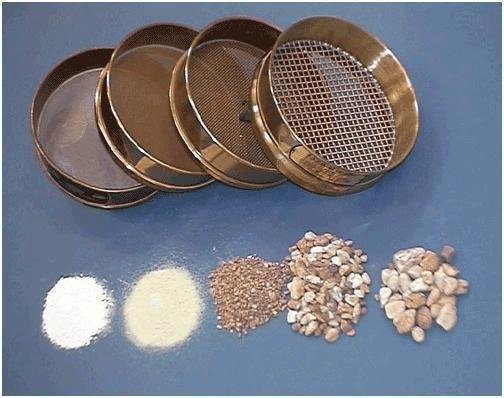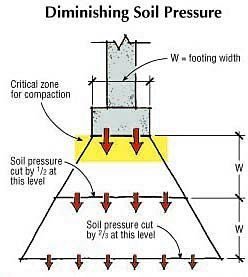Soil Classification
Edited by Zainab Ekram, Sharingknowledge, Jen Moreau, SarMal
The word "Soil" is derived from two Latin words "Solium" meaning seat and "Solum" meaning ground. Soil is also named as "Pedolith" that means ground stone. The study of soil origin, composition and its properties is known as "Pedology".Soil is the outermost layer of earth crust, and has a direct contact and connection with life on earth.
Soil Origin
Soil is the product of the decomposed rocks. This decomposition can be physical, chemical, climatic or biodegradation. Properties of soil are derived from its parent rock.
There are three types of rocks. These are:
- 1Igneous rocks are formed due to the cooling of lava from a volcano. Igneous rock is rich in minerals and molten metal. When lava solidifies at a very slow rate inside the earth's crust/surface, the result is a rock called intrusive or plutonic rock. When lava erupts and flows out of the crust and then freezes, such rock is called extrusive or volcanic rock.Igneous Rock.Advertisement
- 2Sedimentary rock is formed by transportation and deposition of mineral particles. Sediments weathered from the parent rock are transported to a new location by mean of rivers or an other medium. These sediments are compacted layer by layer and are also known as stratified rocks.Sedimentary Rock.
- 3Metamorphic rock is formed under high pressure and temperature below the earth's surface.The rock undergoes re-crystallization due to metamorphism. For example, Calcite or chalk, which is reactive and soluble, is converted into non-reactive marble due to the application of high pressure and temperature.Metamorphic Rock.
When any of these three rocks undergo disintegration, soil is formed. Due to changes in temperature the pores of the rocks freeze causing an increase in volume and resulting in the physical integration of rock. If the alkaline content of soil reacts with water or other minerals, it is termed chemical weathering. The activities of insects and microorganism result into biodegradation of rock. Precipitation and other natural calamities bring climate weathering of rock. Regardless of the method the rock is disintegrated, soil has all the chemical properties derived from its parent rock.
Soil Composition
- 1Soil is categorized into four types depending on its particle size. The grain size distribution of soil is analyzed by sieve analysis. Sieve analysis involves the use of a filter with different mesh spacing arranged in order to measure soil composition. According to The Unified Soil Classification System, particles are categorized as:The composition of soil depends on its mineralogy as well as particle size.
- Gravel. Particle of size greater than 4.75mm (retains on #4 size sieves).
- Sand. Particle size range from 2mm to 4.75mm.
- Silt. Particle size range from 0.075mm to 2mm.
- Clay. Particle of size smaller than 0.075mm (passes through #200 size sieves).
- 2Since the shape of soil particles arbitrarily contain hole and voids, particles of different sizes provide better interlocking and packing of material.
- 1The pores found in the particles of soil are filled with either air or water and are comprised of the following components:
- Soil/ Mineral
- Water
- Air
- 2The void ratio and porosity affect the density of soil samples. There are two types of soil density:The properties of soil significantly vary depending on the air and water content.
- Bulk Density. Bulk density is density of soil in the presence of pore water, mathematically:
ρ= (M_s+M_w)/(V_s+V_w+V_a )= M_t/V_t
- Bulk Density. Bulk density is density of soil in the presence of pore water, mathematically:
- 3
- 4Dry Density
Dry density is density of dry soil with there is no pore water, mathematically:
ρ_d= M_s/(V_s+V_w+V_a )= M_s/V_t
- The water content of soil is measured by:
ω= M_w/M_s = W_w/W_s
- The void ratio, porosity, and saturation are respectively defined as below:
e= V_v/V_s n= V_v/V_t S= V_w/V_v
Soil Properties
- Plasticity. The plasticity of soil is dependent on its water content and classified in states:
- 1The liquid limit is the water content at which the soil behavior changes from that of a liquid to that of a plastic solid.Liquid state.
- 2The plastic limit is the water content at which the soil behavior transitions from that of a plastic solid to a breakable solid.Plastic state.
- 3Shrinkage, The shrinkage limit corresponds to a water content below which the soil will not shrink when it dries.
The Plasticity Index is defined as the difference between the liquid limit and the plastic limit and defines the absorbing capability of soil content. Liquidity index is defined as the effects of the water content on the strength of saturated remoulded soils.
- Conductivity. The capability of soil to allow the fluid flow over it and through the pores is called conductivity or seepage. Darcy's law defines the seepage as, the greater the area of soil, the more the flow rate. Flow rate also depends on the slope of the surface, fluid viscosity, and change in pore pressure with the distance. Mathematically,
Q=(kA (u_b-u_a))/(μ L)
Sandy soil has good conductivity when compared to clay soil. Clay soil has micro size voids. Water raised into these pores in the result of capillary action. Some clay soil also has expansive property due to the absorbed water in pores.
- Consolidation. When pressure is applied to the soil, water from the pores seep out, resulting in a change in volume of soil content. This process is called consolidation. If the sample is dry and pressure is applied, the soil content will be compressed, particles will come closer together and voids will fill. The change of volume, in this case, is due to the removal of air from voids. This process is called compaction. Consolidation of soil may result in settlement of foundation.
- Shear strength of soil depends on the internal friction between soil particles. Soil with good interlocking and friction possess high strength and stiffness. The friction of soil also gives slope stability of soil embankment. More the coefficient of friction of soil, greater will be the angle of repose. The strength of soil can be studied using stress-strain curve.
- Bearing Capacity.Bearing capacity is the ability of soil to resist stress due to structural loading without shear failure and settlement. Soil is tested prior to construction of a project. Geotechnical reports are provided to the design engineers to work out sizes of the foundation that distribute the structural loading to the soil.
Referencing this Article
If you need to reference this article in your work, you can copy-paste the following depending on your required format:
APA (American Psychological Association)
Soil Classification. (2017). In ScienceAid. Retrieved Apr 25, 2024, from https://scienceaid.net/Classify_SoilMLA (Modern Language Association) "Soil Classification." ScienceAid, scienceaid.net/Classify_Soil Accessed 25 Apr 2024.
Chicago / Turabian ScienceAid.net. "Soil Classification." Accessed Apr 25, 2024. https://scienceaid.net/Classify_Soil.
If you have problems with any of the steps in this article, please ask a question for more help, or post in the comments section below.
Comments
Article Info
Categories : Pedology
Recent edits by: Jen Moreau, Sharingknowledge, Zainab Ekram
Thanks to all authors for creating a page that has been read 142 times.













